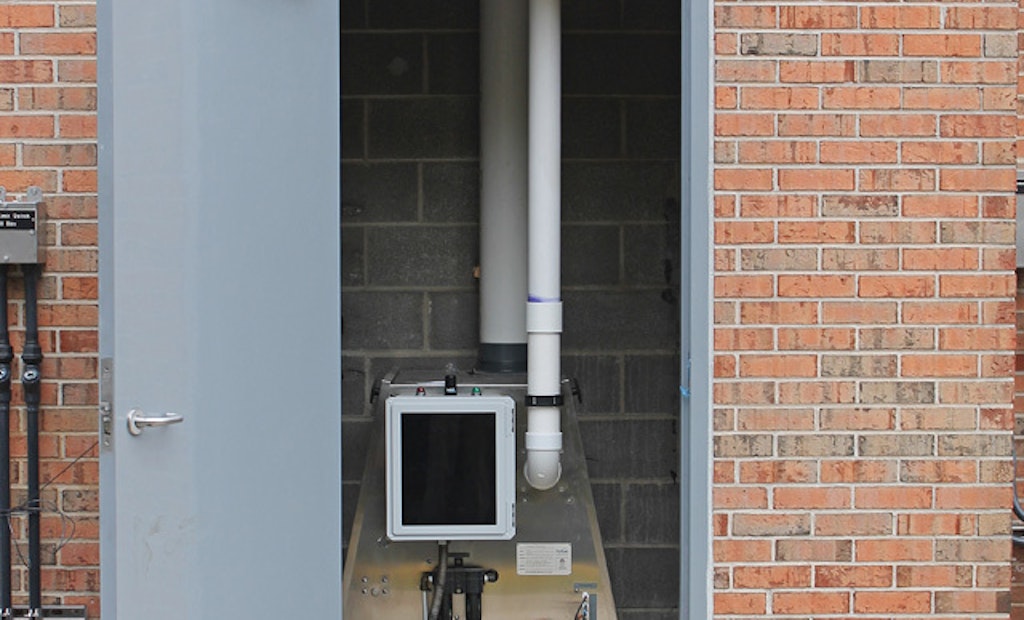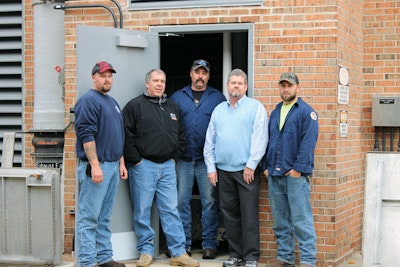
Interested in Cleaning?
Get Cleaning articles, news and videos right in your inbox! Sign up now.
Cleaning + Get AlertsOdors from the Gray Manor pumping station in Baltimore County, Md., were so bad that one neighbor complained to the newspaper, saying she couldn’t run the circulating fans in her windows in the summertime.
But you don’t find newspaper articles about the smell anymore. That’s because the pump division of Baltimore County Utilities has installed an odor control system based on hydroxyl radical fogging technology. Operational since last August, the OHxyPhogg V250 system from Parkson Corp. has eliminated hydrogen sulfide odors that used to prompt calls to county council members from neighbors and negative publicity in the local news media.
“We don’t hear anything now,” says John Guido, operations supervisor for the pumping and treatment division. “And that’s a good thing.”
Close to neighborhoods
The Baltimore County sewage system handles 40 billion gallons of wastewater a year and includes 3,000 miles of sewer pipe and 60,000 manholes. Guido’s division operates and maintains 224 pumps at 117 pumping stations, one community treatment plant, three treatment and water distribution systems, and 2,500 grinder systems at individual homes.
The Gray Manor location is surrounded by homes and commercial establishments and is one of the largest pumping stations in the system. On average, it handles 6 to 8 mgd, and the flow can run higher during storms. The wet well pumps are driven by 700 hp motors.
“Hydrogen sulfide odors had been persistent at the site,” says Guido. For the past few years, his team of mechanic III Mike Cooper, mechanic II Jay Tawes, and mechanic I Justin Yokubinas had used a masking agent with little impact.
“We had tried using a misting system that sprayed an orange blossom scent around the pump station,” says Guido. “It had a marginal effect, and the misting system was costly and maintenance-intensive. When the orange blossom agent ran out, we’d have to go out and install a fresh 55-gallon drum of it. If the system ran dry on a holiday or weekend, the odors went unmasked until our crew came back on the job. It knocked down some of the odors, but not all.”
The odors were even worse during an upgrade of the pumping station, prompting the calls from neighbors.
“At first, we considered replacing the orange blossom scent mister with ozone, but then Parkson introduced us to the OHxyPhogg system,” says Guido. The company gave a 30-day pilot test at another pumping station in November 2010.
Fast response
OHxyPhogg systems use an air atomizing three-fluid nozzle developed by Vapex Environmental Technology that combines ozone with a rapid application of micron-sized water droplets. The result is a hydroxyl radical fog that can be dispersed throughout the odorous air space, generating a large reaction surface area and oxidizing the odors.
The technology is being used successfully in lift stations, wet wells, covered sludge thickeners and holding tanks, and other odorous spaces. The systems require only a potable water source and a 110 VAC or 220 VAC electrical connection.
The pilot study was designed to determine the ability of the technology to reduce or eliminate hydrogen sulfide odors inside the wet well structure. A second aim was to test the effectiveness of the fogging system in reducing or preventing grease buildup and corrosion on the structure walls.
The results were excellent. Monitors recorded average hydrogen sulfide levels of 22 ppm in the wet well, and even higher levels in the diverter box, before operation of the fogging system. Once the system went online, the hydrogen sulfide dropped to 0 to 3 ppm at various points in the wet well. The test showed a reduction in grease and corrosive gases, as well.
“The pilot test station is out away from populated areas, and odors can be very bad,” says Guido. “I thought if the fogging system worked there, it would be a good solution to the Gray Manor situation.”
Easy installation
Under direction of superintendent Mark Thiess, the utility bought an OHxyPhogg V250 unit and worked with Parkson to install it. A utility crew handled the piping. The unit was positioned in a separate small room in the pumping station and connected to electrical service and water. Then Guido’s team ran the fogging pipes into an adjacent room, drilled holes in the floor, and routed the pipes into the wet well below, positioning the fogging heads so they would completely cover the wet well area.
“We made one change by using schedule 80 PVC pipe instead of the schedule 40 that was specified,” says Guido. “It stands up better and is harder to break if something hits it.”
The piping installation took about 12 hours. “We actually did such a good job that Parkson tells us they want to use us as a model,” Guido says.
The system was activated the next day, and the results were evident immediately.
“We could not detect any hydrogen sulfide odors around the pumping station,” Guido says. “The nose is one of the best odor monitors we have. Our operators didn’t smell anything.”
Maintenance has been minimal, and the negative media coverage has ended. “You never hear about a job well done,” Guido says. “As long as the neighbors don’t smell the pump station, we don’t hear anything.”






